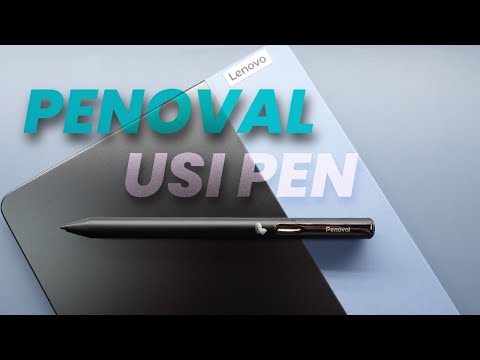
Penoval USI Pen for Chromebook Review & Unboxing
– What is up, everyone?
This is Jojo the Techie.
And today we’re gonna go
over the Penoval USI pen,
which is compatible with
all USI Chromebooks.
We’re also gonna be comparing
it against the Lenovo USI pen,
which I reviewed right over here.
Penoval sent this pen over
for an unboxing and a review,
and that’s exactly what
we’re going to do next.
(upbeat music)
The Penoval USI pen has
a matte, metal finish
with a metal clip.
Penoval promises 4,096 levels of pressure,
no Bluetooth required
and 300 days of use time.
It uses a quadruple A battery,
one of which is included along
with a spare tip and a
pincer to remove the tip.
There is also no power button.
The diameter of the pen tip
is only 1.5 millimeters.
Remove it counter clockwise
and install it clockwise
using the included pincer.
It also promises a palm-rejection
function with Chrome OS,
which works as long as
the tip of the pencil
is resting on the Chromebook
before you rest your palm on it.
Starting to remove the items from the box,
first up is the AAAA battery.
Then let’s just remove the extra tip,
which will come in handy
And then the included pincer,
which is supposed to assist
with removing and putting in the new tip.
And here is the pen.
Very nice matte, metal finish with a clip
and the USI logo clearly visible.
Unscrew the cap
and this way you can
actually include the battery.
Be careful not to remove the spring
which will make contact with the battery.
(upbeat music)
All right, let’s put the battery in.
Screw the cap back on.
And here we are, pen is ready to be used.
Okay, let’s put the pen to the test
with some sketch and writing apps.
First off, let’s try Autodesk Sketchbook.
As you can see, Penoval does deliver
on their promise of palm
rejection on Chrome OS.
All you have to make sure
to do is to put the tip
on the Chromebook before
you set down your palm.
In the first row here, I am
writing with a very light stroke
And let’s try with a different pen size.
And yes, as you can see
my second stroke here,
I apply more pressure
so you can see the pressure sensitivity.
Next up, let’s try Google Keep.
Now Google Keep is not an application that
supports pressure sensitivity,
so pretty much all the strokes
I make look the same.
That is not a reflection
of the Penoval pen
but of the application itself.
Next, let’s try Microsoft One Note.
This app does support pressure sensitivity
and as you can see here,
when I write and I push
the pen further down,
you can see that the stroke is thicker.
(upbeat music)
0:03:50.034,1193:02:47.295
and in the second I’m
applying some pressure.
Lastly, let’s go ahead and try Squid,
which is my favorite note taking app.
And let’s just start with
a normal stroke here.
And as I push my pen
down with more pressure,
you can see that the stroke gets thicker.
So this pen does have pressure
sensitivity as promised.
If I had to compare this
pen to the Lenovo USI pen,
I would say that what
sets it apart the most
is the quality of the construction.
This pen feels more sturdy in the hand.
It has a more metal feel to it.
Even though the Lenovo
USI pen is also metal,
it does feel kind of flimsy.
The top part is kind of plasticy
and there have been a lot
of QA concerns regarding
the spring coming loose
when you open the cap to enter the battery
and other things such as
the pen not responding
as it should, or just poor
construction materials.
I give the Penoval pen a thumbs up.
Let’s take a look at the Penoval USI Pen
Besides the Lenovo USI Pen
and compare
The Lenovo pen is slightly smaller
coming in at 5.4 inches
as opposed to the 5.5 from the Penoval USI pen
As this comparison chart shows
the biggest difference between the two pens
are the pen tip diameter, the weight, and the price
If you enjoyed this review,
don’t forget to click like, subscribe
and hit the notification bell
so you can get notified for my next video.
See you in the next one.
